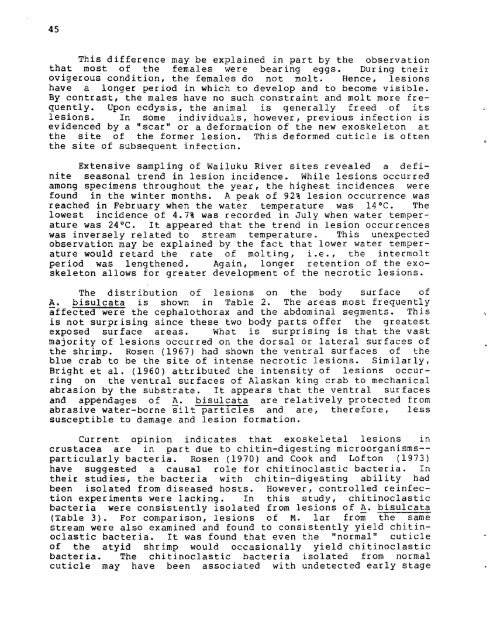June 1 - 3 , 1978 - University of Hawaii at Manoa
June 1 - 3 , 1978 - University of Hawaii at Manoa
June 1 - 3 , 1978 - University of Hawaii at Manoa
You also want an ePaper? Increase the reach of your titles
YUMPU automatically turns print PDFs into web optimized ePapers that Google loves.
This difference may be explained in part by the observ<strong>at</strong>ion<br />
th<strong>at</strong> most <strong>of</strong> the females were bearing eggs. During tneir<br />
ovigerous condition, the females do not molt. Hence, lesions<br />
have a longer period in which to develop and to become visible.<br />
By contrast, the males have no such constraint and molt more fre-<br />
quently. Upon ecdysis, the animal is generally freed <strong>of</strong> its<br />
lesions. In some individuals, however, previous infection is<br />
evidenced by a "scar" or a deform<strong>at</strong>ion <strong>of</strong> the new exoskeleton <strong>at</strong><br />
the site <strong>of</strong> the former lesion. This deformed cuticle is <strong>of</strong>ten<br />
the site <strong>of</strong> subsequent infection.<br />
Extensive sampling <strong>of</strong> Wailuku River sites revealed a defi-<br />
nite seasonal trend in lesion incidence. While lesions occurred<br />
among specimens throughout the year, the highest incidences were<br />
found in the winter months. A peak <strong>of</strong> 92% lesion occurrence was<br />
reached in February when the w<strong>at</strong>er temper<strong>at</strong>ure was 14OC. The<br />
lowest incidence <strong>of</strong> 4.7% was recorded in July when w<strong>at</strong>er temper-<br />
<strong>at</strong>ure was 24OC. It appeared th<strong>at</strong> the trend in lesion occurrences<br />
was inversely rel<strong>at</strong>ed to stream temper<strong>at</strong>ure. This unexpected<br />
observ<strong>at</strong>ion may be explained by the fact th<strong>at</strong> lower w<strong>at</strong>er temper-<br />
<strong>at</strong>ure would retard the r<strong>at</strong>e <strong>of</strong> molting, i .e., the intermolt<br />
period was lengthened. Again, longer retention <strong>of</strong> the exo-<br />
skeleton allows for gre<strong>at</strong>er development <strong>of</strong> the necrotic lesions.<br />
The distribution <strong>of</strong> lesions on the body surface <strong>of</strong><br />
A. - bisulc<strong>at</strong>a is shown in Table 2. The areas most frequently<br />
affected were the cephalothorax and the abdominal segments. This<br />
is not surprising since these two body parts <strong>of</strong>fer the gre<strong>at</strong>est<br />
exposed surface areas. Wh<strong>at</strong> is surprising is th<strong>at</strong> the vast<br />
majority <strong>of</strong> lesions occurred on the dorsal or l<strong>at</strong>eral surfaces <strong>of</strong><br />
the shrimp. Rosen (1967) had shown the ventral surfaces <strong>of</strong> the<br />
blue crab to be the site <strong>of</strong> intense necrotic lesions. Similarly,<br />
Bright et al. (1960) <strong>at</strong>tributed the intensity <strong>of</strong> lesions occurring<br />
on the ventral surfaces <strong>of</strong> Alaskan king crab to mechanical<br />
abrasion by the substr<strong>at</strong>e. It appears th<strong>at</strong> the ventral surfaces<br />
and appendages <strong>of</strong> A. bisulc<strong>at</strong>a are rel<strong>at</strong>ively protected from<br />
abrasive w<strong>at</strong>er-borne silt particles and are, therefore, less<br />
susceptible to damage and lesion form<strong>at</strong>ion.<br />
Current opinion indic<strong>at</strong>es th<strong>at</strong> exoskeletal lesions in<br />
crustacea are in part due to chitin-digesting microorganisms--<br />
particularly bacteria. Rosen (1970) and Cook and L<strong>of</strong>ton (1973)<br />
have suggested a causal role for chitinoclastic bacteria. In<br />
their studies, the bacteria with chitin-digesting ability had<br />
been isol<strong>at</strong>ed from diseased hosts. However, controlled reinfec-<br />
tion experiments were lacking. In this study, chitinoclastic<br />
bacteria were consistently isol<strong>at</strong>ed from lesions <strong>of</strong> A. bisulc<strong>at</strong>a<br />
(Table 3). For comparison, lesions <strong>of</strong> M. lar from the same<br />
stream were also examined and found to consistently yield chitin-<br />
oclastic bacteria. It was found th<strong>at</strong> even the "normal" cuticle<br />
Of the <strong>at</strong>yid shrimp would occasionally yield chitinoclastic<br />
bacteria. The chitinoclastic bacteria isol<strong>at</strong>ed from normal<br />
cuticle may have been associ<strong>at</strong>ed with undetected early stage
















